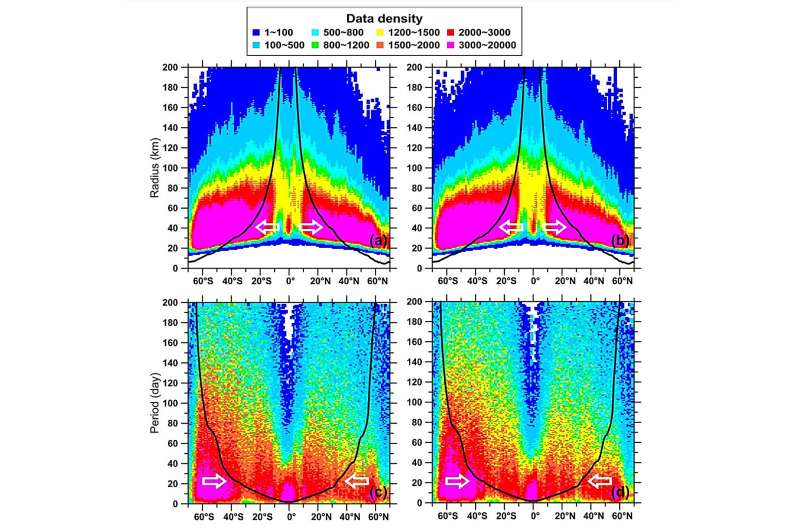This article has been reviewed according to Science X's editorial process and policies. Editors have highlighted the following attributes while ensuring the content's credibility:
fact-checked
peer-reviewed publication
trusted source
proofread
Researchers investigate meridional deflection of global eddy propagation derived from tandem altimetry

Since the finding of their ubiquitous presence in the ocean decades ago, mesoscale eddies have been recognized as key contributors in transporting heat and substances. A common view on the meridional deflection of eddy propagation is poleward for cyclones and equatorward for anticyclones.
However, by analyzing nearly 30 years of altimeter-derived eddy tracking datasets, a research team found that this widely accepted polarity-sensitive pattern has been increasingly undermined given that it is systematically violated on both zonal and regional scales. Instead, the primary pattern of eddy deflection appears to be geographically correlated and polarity-independent.
To examine the geographic dependency of eddy deflection, a climatology of eddy meridional deflection map is created with prominent equatorward/poleward deflecting zones identified: Prominent equatorward deflecting zones are observed in the eastern parts of mid-latitude Pacific and Atlantic of the two hemispheres, while basin-scale poleward deflecting zones exist in the tropical oceans as well as along the main paths of the western boundary currents such as the Kuroshio and the Gulf Stream.
This study is led by Prof. Ge Chen (Frontiers Science Center for Deep Ocean Multispheres and Earth System, School of Marine Technology, Ocean University of China). The findings are published in the journal Science China Earth Sciences.
"We further divide the map into westward/eastward propagating anticyclonic/cyclonic eddies. Quite surprisingly, not only the basin-scale patterns reappear, but also the regional scale features retain, suggesting that, to the zero-order approximation, meridional deflection of eddy motion is geographically correlated, irrespective of other eddy properties such as polarity or zonal propagation direction," Prof. Chen says.
The team found that geostrophic adjustment plays a critical role in defining the meridional movement of an eddy. Specifically, a consistent poleward (equatorward) trajectory bending of spatially (temporally) ageostrophic eddies is observed irrespective of their polarity.
In the initial stage of an ageostrophic eddy identified by its spatial scale, it is small in size and asymmetric in shape, having a tendency of a gradual increase to a relative maximum at higher latitude when it becomes comparable to the Rossby deformation radius where a geostrophic balance can be reached. The mechanism of eddy deflection is also determined by its zonal propagation direction. Westward propagating eddies are substantially affected by thermal fading, while opposite ones by flow dragging.
Ocean eddy is known for its strong capability of basin-wide substance transport, having a potentially global impact which might be positive (if, e.g., nutrient is entrained) or negative (if, e.g., pollutant is entrained). To avoid misleading consequences in eddy science, the superficial description of polarity determined poleward/equatorward deflection needs to be replaced by a geographically dependent characterization which takes into account the principal mechanisms involved.
Hopefully, a realistic and comprehensive understanding of eddy deflection will make a significant contribution to the prediction of eddy trajectory, and the protection of ocean environment.
More information: Ge Chen et al, Meridional deflection of global eddy propagation derived from tandem altimetry: Mechanism and implication, Science China Earth Sciences (2024). DOI: 10.1007/s11430-023-1264-8
Journal information: Science China Earth Sciences
Provided by Science China Press




















